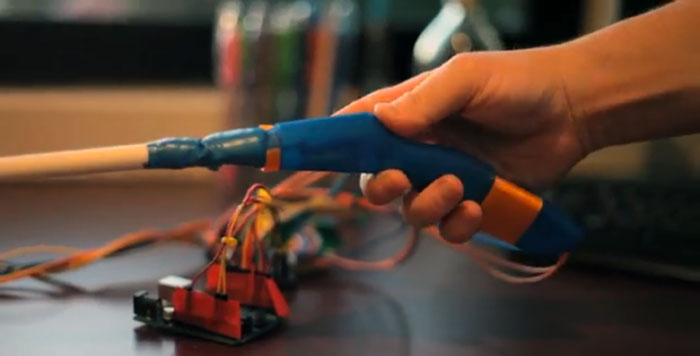While researching the concept of voxel 3D printing, I accidentally found my way to a unique device made to aid the visually impaired. It just so happened to be called Voxel and involve 3D printing, though it was in no way related to voxel 3D printing. No, this Voxel is a 3D printed cane to assist those with low vision in getting around.
How the cane works is through a link to an iPhone app. A specific location is typed into the app and a series of directions to that location are generated. The handle of the cane is embedded with a vibration device so that, as a visually impaired person makes his/her/zir way to the desired location, the cane vibrates to indicate an upcoming turn and the app speaks aloud the direction they need to take. In addition to the vibrating handle, the base of the cane contains LED lights, which change colour as the cane approaches an obstacle, moving from white, to green, to blue and to red, depending on the cane’s distance from an object. Watch a promo for Voxel below:
If you’re like me, you might wonder, how would a visually impaired person be able to see LED lights? Voxel is meant for those with low-vision, brought about by such medical issues as macular degeneration, and not complete blindness. As the cane’s designer, Sarah Mote, explains, “An estimated 285 million people worldwide are visually impaired, with 39 million of those blind and 246 [million] having low vision.” Users of the cane would still have some vision and would be able to register the colours of the LED lights, hypothetically. Mote believes that such a tool would enable the visually impaired to adapt to using a cane, while becoming more aware of their surroundings.
The cane is still a prototype, as you can gauge from the exposed wires in the promotional video. If the cane were ever manufactured, through 3D printing, Mote suggests that users would be able to customize the designs of Voxel. This might mean anything from a specific look or colour to a personally tailored, ergonomic grip. What’s most interesting to me about the device is that its designer is aware of the gap between those with total blindness and those with adequate vision. Despite the portrayal of the visually impaired in movies and TV as completely lacking sight, Mote gears her product towards a potentially ignored population. Kudos, Sarah!




